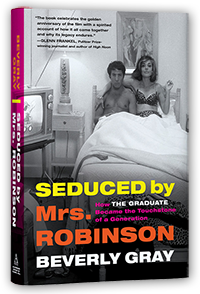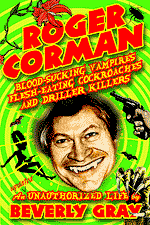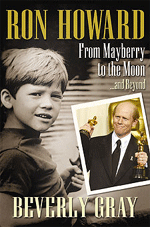Ah, the memories! Though author Christopher Koetting hasn’t spoken directly to Corman and his graduates, he has done a solid job of compiling quotes and telling details from every published book and article about the maestro’s New World days, which span the period 1970 to 1983. I’m gratified, of course, that he seems to have found my Roger Corman: Blood-Sucking Vampires, Flesh-Eating Cockroaches, and Driller Killers particularly useful. It’s always nice to feel you’ve contributed to someone else’s scholarship, especially when you’re graciously acknowledged in print. No, I don’t know Christopher Koetting from Adam (Sandler), but he’s obviously a man of good taste!
Though, certainly, good taste was never the point at New World Pictures. The place was lovingly satirized by my irrepressible chums Joe Dante, Allan Arkush, and Jon Davison as Miracle Pictures: “If it’s a good picture, it’s a Miracle.” Their film spoof containing that hoary joke was entitled Hollywood Boulevard; in typical New World fashion it flaunted the tagline “The street where starlets are made.” When Joe, Jon, and Allan shot Hollywood Boulevard (in nine days, then padded it out with lots of New World stock footage), their highest goal was to photograph themselves beneath the marquee that advertised the movie. Today, to their surprise, they can all look back on significant Hollywood careers.
I myself didn’t work on Hollywood Boulevard, but I plead guilty to collaborating on a lurid women-in-prison film as well as several of the infamous Corman nurse movies (“Keep abreast of the medical world with the Candy Stripe Nurses”) And—in perhaps the highlight of my New World career—I came up with the twist that ended Death Race 2000.
I also rounded up the designers of those goofy Death Race cars, helped think of creative ways to run people over, and met Sylvester Stallone, dressed in ominous black for his audition as Machine Gun Joe Viterbo. It fascinates me that when Death Race was remade in 2008 as a big-budget Jason Statham action flick, the most perverse idea in the original—that drivers scored points by mowing down pedestrians—was nowhere to be seen. No one can claim that we live in a tasteful age, but the merry mayhem of Death Race 2000 was perhaps a trifle too outrageous for the 21st century.








Wonderful post, Beverly! I could go on and on talking about the highlights and lovably low brow moments generously peppered throughout the exploitation love letter that is HOLLYWOOD BOULEVARD. I've seen the film a few times now and always seem to find something I missed on a previous viewing.
ReplyDeleteI haven't watched it in some time, but I'll have to give CANDY STRIPE NURSES another spin and check out your cameo!
Regarding DEATH RACE 2000, you'd think as much as that film foreshadowed the onslaught of "reality TV" and mankind's preoccupation with seeing acts of violence that the newer version would have capitalized on this. I haven't seen the recent DEATHRACE sequel yet.
Also, I take it that the blackly humorous, yet grotesque nature of the violence in the movie went over some peoples heads back then, not quite knowing how to take what they were witnessing. I do remember my mom watching this with me (she being a huge Stallone fan at the time) and refusing to finish it due to the balancing of extreme violence laced with cruel comedy.
I wonder if DEATH RACE 2000 was influential on Troma's THE TOXIC AVENGER (1984)? They borrowed the "points for pedestrians" device in a similarly brutal, yet blackly humorous fashion for a quartet of antagonists. Still, Bartel's vision is one of a more enlightening exploitation endeavor while Troma's usage of this was purely for sensationalistic purposes.
This comment has been removed by the author.
ReplyDeleteAS I suspect you know, the "points for pedestrians" business was around (as part of school playground banter etc.) long before the Corman movie. What's interesting to me is that this was part of the Ib Melchior story on which the film was based, though that story was by no means a dark comedy. I've seen Roger Corman, in a recent interview, take credit for personally coming up with the "points for pedestrians" notion. Sorry, Roger, but Melchior got there first. One of these days, I should probably tell the whole story!
ReplyDeleteTHE RACER I think was the name of it? I've not seen Melchoir's treatment, but I believe it was an excerpt from your book where Bartel talks about how "kinky" the original script was?
ReplyDeleteYes, the story is called "The Racer." It's ultimately rather sentimental -- the main character sees the error of his ways. As for the screenplay, there was an original writer who never gets mentioned, then Robert Thom -- that was the "kinky" script. (It was also impossible to film.) I'm not sure I quoted Paul's description of it, but I know Chris Koetting did in Mind Warp! Do remind me to go into more detail on all this at some point. Great stuff!
ReplyDeleteWhat a great post - my dream of heaven might just be to work for New World in the 70's and 80's. Cheers!
ReplyDeleteThanks, Craig. The Corman experience was perhaps best summed up by Deborah Brock, who spent years at the head of Roger's post-production team: “It was like you were constantly having the worst day of your life. But in between having the worst day of your life you could have a lot of fun. So it was continually elating and horrible.”
ReplyDelete